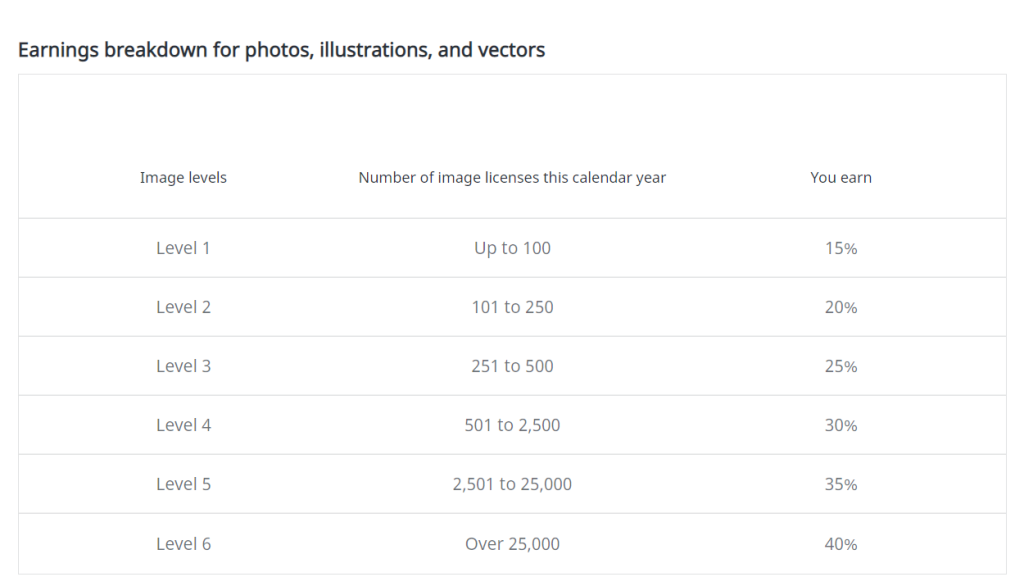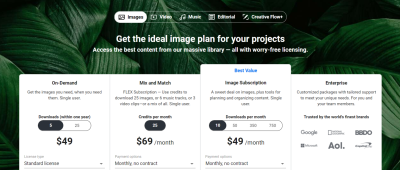If you’re passionate about photography or digital art and wondering how to turn that passion into income, Shutterstock might be a great platform to explore. As a contributor, you have the chance to earn money whenever someone downloads your images. But how exactly are those earnings calculated? Understanding the ins and outs of Shutterstock‘s contributor earnings can help you strategize better and maximize your income. Whether you’re just starting out or looking to refine your approach, knowing how the payment system works is key to making the most of your creative efforts.
Factors Influencing Shutterstock Image Payment Rates

When it comes to how much you earn per image download, several factors come into play. Shutterstock‘s payment rates aren’t fixed; they depend on various elements that can influence your overall income. Here’s what you should keep in mind:
- Contributor License Level: Shutterstock has a tiered system that rewards contributors based on their overall performance and sales volume. As you submit more high-quality images and earn more, you can move up the levels—Standard, Enhanced, and Exclusive—each offering different earning potentials.
- Download Type: The way customers purchase images matters. Shutterstock offers Standard and Enhanced licenses. Standard licenses are less expensive and generate lower royalties, while Enhanced licenses, which are often used for commercial purposes, tend to pay higher rates.
- Subscription vs. On-Demand Downloads: Many customers subscribe to Shutterstock plans, which means they pay a monthly fee to download a certain number of images. The payout per download in this case is typically lower. On the other hand, single-image purchases (on-demand) usually yield higher royalties.
- Image Quality and Relevance: High-quality, popular, and relevant images tend to sell more and earn higher royalties. Shutterstock’s algorithm favors images that are trending or in demand, so investing time in creating versatile and appealing content can pay off.
- Exclusive vs. Non-Exclusive Content: If you choose to be an exclusive contributor, you might earn higher royalties because Shutterstock offers better rates for exclusive content. However, this also means you can’t sell those images elsewhere.
Other elements like seasonal trends, current events, and emerging industries can also influence how often your images are downloaded and how much you earn. Staying informed about market trends and continuously improving your portfolio can help you optimize your earning potential on Shutterstock. Remember, building a successful contributor profile takes time, patience, and effort—but understanding these factors puts you in a better position to succeed.
How Much Do Contributors Earn per Image on Shutterstock
One of the big questions many aspiring contributors have is, “How much can I actually make per image on Shutterstock?” Well, the answer isn’t a one-size-fits-all because earnings depend on several factors, including your contributor level, the type of license purchased, and your overall sales volume.
Shutterstock operates on a tiered royalty system, meaning the more images you sell, the higher your earning percentage becomes. When you’re just starting out, you’ll typically earn a lower rate, but as your portfolio grows and you make more sales, your percentage increases. Here’s a quick breakdown:
| Contributor Level | Sales Range | Earning Rate per Download |
|---|---|---|
| Standard | 0 – 1,000 downloads | 20-30% |
| Advanced | 1,001 – 10,000 downloads | 30-40% |
| Elite | 10,001+ downloads | 40-50% |
For example, if your image is licensed under a standard license and sells for $29, you might earn around 20-30% of that, which is roughly $5.80 to $8.70. If your image is licensed under an enhanced license, the sale price could be higher, and so would your earnings.
It’s also worth noting that Shutterstock offers different types of licenses—standard and enhanced—and each has different associated prices. Enhanced licenses can go for hundreds of dollars, which significantly boosts your potential earnings per sale.
Remember, your total earnings will depend on how many images you upload, how often they sell, and your contributor level. The more popular your images become, the more you stand to earn per download. So, creating high-quality, in-demand images can really make a difference in your income on Shutterstock.
Tips to Maximize Your Earnings as a Shutterstock Contributor
Looking to boost your earnings? You’re in the right place! Earning more on Shutterstock isn’t just about uploading a ton of images—it’s about strategic effort, quality, and understanding the platform. Here are some practical tips to help you get the most out of your contributor journey:
- Create High-Quality, Unique Content: First and foremost, focus on producing sharp, well-composed, and original images. Unique content that fills gaps in Shutterstock’s library tends to sell better.
- Research Trends and Demand: Keep an eye on trending topics, seasons, and popular themes. Use Shutterstock’s trending searches or tools like Google Trends to find what buyers are looking for.
- Optimize Your Metadata: Use clear, descriptive titles, tags, and keywords. Proper metadata helps your images appear in relevant searches, increasing visibility and sales.
- Upload Consistently: The more quality images you upload regularly, the better your chances of making sales. Consistency helps build your portfolio and improve your visibility on the platform.
- Focus on Niche Markets: Specializing in a niche—like medical illustrations, food photography, or business backgrounds—can set you apart and attract dedicated buyers looking for specific content.
- Engage with Shutterstock Community: Participate in forums, read contributor blogs, and stay updated on platform changes. Networking can provide valuable insights and tips.
- Monitor Your Sales and Adjust: Review which images sell best and why. Use that data to guide your future uploads—produce more of what works and refine what doesn’t.
- Leverage Promo Opportunities: Occasionally, Shutterstock offers promotional deals or highlights certain images. Being active and strategic can help your images gain extra exposure.
- Be Patient and Persistent: Building a steady income takes time. Keep uploading, refining your skills, and staying motivated—success rarely happens overnight.
By combining high-quality content with smart marketing and consistent effort, you’ll set yourself up for higher earnings. Remember, becoming a successful Shutterstock contributor is a marathon, not a sprint. Keep learning, adapting, and creating—your efforts will pay off in the long run!
Conclusion and Final Thoughts on Shutterstock Image Pricing
Understanding Shutterstock contributor image pricing rates is essential for maximizing your earnings and setting realistic expectations. As a contributor, it’s important to recognize that pricing varies based on several factors, including licensing type, image resolution, and contributor exclusivity. Generally, Shutterstock operates on a tiered royalty system, where higher sales volumes can lead to increased earning percentages. Affiliates and exclusive contributors often benefit from higher payout rates compared to non-exclusive contributors.
Here are some key points to keep in mind:
- Pricing Structure: Shutterstock offers different licensing options, primarily Standard and Enhanced licenses, which impact your earnings.
- Royalty Rates: Contributors earn a percentage of the sale price, typically ranging from 15% to 40%, depending on your contributor level and sales volume.
- Exclusive vs. Non-Exclusive: Exclusive contributors generally receive higher royalties, but this comes with restrictions on selling identical images elsewhere.
- Additional Revenue Streams: Contributors can also benefit from subscription sales and image packs, which influence overall earnings.
| Contributor Level | Royalty Rate |
|---|---|
| Standard | 15-20% |
| Premium | 25-30% |
| Elite | 35-40% |
In conclusion, understanding these variables helps you strategize better, optimize your portfolio, and increase your revenue as a Shutterstock contributor. Keep track of your sales, stay updated on platform changes, and continuously improve your content to maximize your earning potential.


